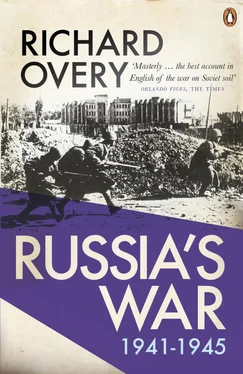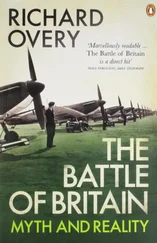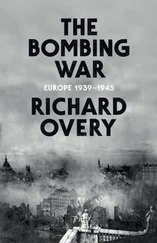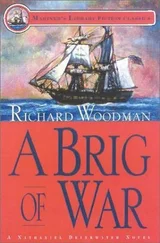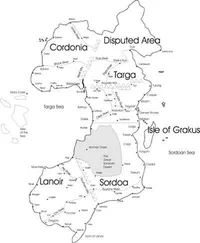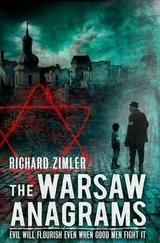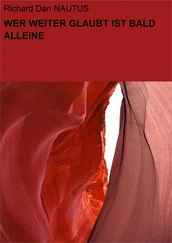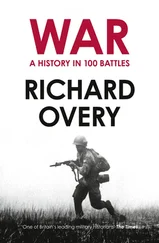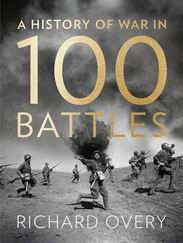Richard Overy - Russia's War
Здесь есть возможность читать онлайн «Richard Overy - Russia's War» — ознакомительный отрывок электронной книги совершенно бесплатно, а после прочтения отрывка купить полную версию. В некоторых случаях можно слушать аудио, скачать через торрент в формате fb2 и присутствует краткое содержание. Город: London, Год выпуска: 1999, ISBN: 1999, Издательство: Penguin Books Ltd, Жанр: military_history, на английском языке. Описание произведения, (предисловие) а так же отзывы посетителей доступны на портале библиотеки ЛибКат.
- Название:Russia's War
- Автор:
- Издательство:Penguin Books Ltd
- Жанр:
- Год:1999
- Город:London
- ISBN:978-0-14-192512-7
- Рейтинг книги:4 / 5. Голосов: 1
-
Избранное:Добавить в избранное
- Отзывы:
-
Ваша оценка:
- 80
- 1
- 2
- 3
- 4
- 5
Russia's War: краткое содержание, описание и аннотация
Предлагаем к чтению аннотацию, описание, краткое содержание или предисловие (зависит от того, что написал сам автор книги «Russia's War»). Если вы не нашли необходимую информацию о книге — напишите в комментариях, мы постараемся отыскать её.
[Contain tables. Best viewed with CoolReader.]
Russia's War — читать онлайн ознакомительный отрывок
Ниже представлен текст книги, разбитый по страницам. Система сохранения места последней прочитанной страницы, позволяет с удобством читать онлайн бесплатно книгу «Russia's War», без необходимости каждый раз заново искать на чём Вы остановились. Поставьте закладку, и сможете в любой момент перейти на страницу, на которой закончили чтение.
Интервал:
Закладка:
Stalin was the driving force behind the ‘Second Revolution’. His ambition was to turn a backward and inefficient state into a modern industrial society in ten years. It was a uniquely revolutionary ambition, which shaped the Soviet state and the Soviet peoples down to the collapse of the system in the 1990s. Together with the Five-Year Plans for industrial modernization the Party radicals recognized that the countryside – the prime cause of Soviet backwardness in the Communist view – had to undergo its own social revolution. In place of the millions of small private communes which had been formed since the revolution, as peasants seized the land for themselves, the state began to impose collectivization (the substitution of large state-owned farms run by Communist managers) and a new rural wage-labour force. The assault on peasant independence began in 1927 and was completed almost five years later. Millions were moved from the villages to the cities, where they were compelled to adopt an utterly different life. Millions refused or resisted and were taken as forced labour to build the infrastructure of the new economic system under the harshest conditions of work. The damage done to peasant life produced wide unrest in what was largely a peasant-based army. The collectivization programme was enforced not by the military, whose loyalty was doubtful, but by the special troops of the NKVD, the Internal Affairs Commissariat. In a little over ten years Soviet cities swelled by more than 30 million people; in 1926, four-fifths of Soviet society had lived and worked on the land; in 1939 the figure was down to just half. The industrial and agricultural policies of the 1930s produced the social revolution that Lenin could not produce in 1917.
Despite formidable obstacles to the provision of skilled labour, capital equipment and finance, the industrial revolution was pushed through. Behind the revolutionary rhetoric and dubious statistics there lay real achievement. The latest Western estimates of Soviet production in the 1930s still tell a remarkable story: steel output rose from 4.3 million tons in 1928 to 18.1 million a decade later; coal production more than trebled, from 35 million tons to 133 million; truck production, an insignificant 700 at the start of the plans, reached 182,000 in 1938. 30The programme of industrialization was presented as a second civil war against the enemies of social change, chief among them the rich peasant or kulak , the saboteur and hooligan who held back economic progress, and the ideological deviationist who undermined popular commitment to change. The military language of ‘struggle’, ‘battle’, ‘victory’ and ‘enemy’ was not accidental. The regime saw counter-revolutionaries as the shock troops of foreign imperialism. The campaign for modernization was not simply about the survival of Communism in a backward society, but about the survival of the Soviet Union in a world of hostile capitalist powers.
Amidst the poverty and violence of working-class life in the Soviet Union under the three Five-Year Plans which spanned the period from 1927 to the outbreak of war, there surfaced a genuine popular enthusiasm for the tasks set by the Party. It was expressed in a country-wide culture of ‘socialist emulation’, exemplified by the young peasant-turned-miner from the Donbas region, Aleksandr Stakhanov. On 30 August 1935, Stakhanov, already deemed to be a model worker for regularly exceeding the modest norm of 6.5 tons per five-hour shift, worked non-stop through the night to produce 102 tons of coal. This was double the amount normally produced by the whole squad of eight miners working at the coalface, and it earned Stakhanov 200 roubles instead of the usual 30. At six in the morning the mine manager, Konstantin Petrov, called an emergency meeting of the Party committee of the enterprise. The early hour was explained by the news Petrov had to announce: a new world record for mining productivity. Not to be outdone, Stakhanov’s comrades rushed to exceed his achievement: three days later the record tumbled. On 7 September a miner at the Karl Marx mine hewed 125 tons. A day later the editors of Pravda , keen to make what capital they could out of a man they nicknamed ‘the Soviet Hercules’, reported that a Red Army soldier on leave had dug 240 tons in six hours. The results were in fact achieved with a good deal of assistance from other workers, but the new soldiers of the industrial front won instant recognition. The ‘shock workers’, as they were called, were rewarded with extra pay and rations and better housing. By 1939 there were over 3 million exceptional workers, laden with medals for industrial heroism. When Stakhanov died at a ripe age in 1977, his home town was renamed in his honour, the only Soviet city to bear the name of a humble worker. 31
The military strengthening of the Soviet Union was the most significant consequence of the ‘Second Revolution’. The first Five-Year Plan gave priority to heavy industry and machine engineering, as Lenin’s theory of economic development dictated. But from the early 1930s the industrial system began to turn out large quantities of weapons. At the beginning of 1928 the Red Army had 92 tanks; by January 1935 there were 10,180. In 1928 the air force had 1,394 aircraft of all kinds; in 1935 6,672. Fighter output increased fivefold between 1930 and 1934, bomber output by a factor of four. The significant figure was the proportion of the national product devoted to the defence sector. In 1913 it was 5.2 per cent; in 1932 it was already 9 per cent, more than double the figure at the outset of the plans; by 1940 it was 19 per cent. By 1932 one-quarter of all capital investment in heavy industry and engineering was in defence-related areas. 32These figures represented an exceptional level of commitment to defence in peacetime. Arms were bought at the expense of living standards. Under the economic regime of the Five-Year Plans consumer goods were suppressed in favour of military output and the heavy industrial sectors vital to future war-making. The turning point in the military effort came in 1931. In February of that year Stalin addressed the first All-Union Congress of Managers, where he emphasized the priority of Soviet security in what became one of the few memorable speeches of his career:
One feature of the old Russia was the continual beatings she suffered for falling behind, for backwardness. She was beaten by the Mongol khans. She was beaten by the Turkish beys. She was beaten by the Swedish feudal lords. She was beaten by the Polish and Lithuanian gentry. She was beaten by the British and French capitalists. She was beaten by the Japanese barons. All beat her – for her backwardness…. We are fifty or a hundred years behind the advanced countries. We must make good this distance in ten years. Either we do it or they crush us. 33
This was Stalin’s most important statement on the relationship between military power and economic modernization. It was followed by a sharp acceleration in military output and the military budget.
One of the first results of Stalin’s new military course was the rehabilitation of Tukhachevsky. In May 1931 he was brought back from exile in the Leningrad Military District to become Chief of Armaments; he was chief of staff again by 1934. Stalin and Voroshilov were now inclined to accept the Tukhachevsky strategic vision of massed tanks and aircraft, even to endorse the strategy of deep penetration, now that tanks and military vehicles were pouring off the assembly line. The Tukhachevsky plan called for 15,000 operational aircraft. In 1930 there were just over 1,000. By 1935 there were between 4,000 and 5,000, vastly greater than the air force of any other power. The mechanization plan called for a total of 90,000 tanks on mobilization. Tukhachevsky favoured bridging the gap between the modest tank force available in the mid-1930s and the giant tank armies of the future by utilizing 40,000 tractors from the factories supplying the collective farms, protected with armour plate and each carrying a heavy machine-gun. The development of fast tanks with large-calibre guns was made a priority, producing by the late 1930s the prototype of the famous T-34, the chief Soviet battle tank of the Second World War. 34
Читать дальшеИнтервал:
Закладка:
Похожие книги на «Russia's War»
Представляем Вашему вниманию похожие книги на «Russia's War» списком для выбора. Мы отобрали схожую по названию и смыслу литературу в надежде предоставить читателям больше вариантов отыскать новые, интересные, ещё непрочитанные произведения.
Обсуждение, отзывы о книге «Russia's War» и просто собственные мнения читателей. Оставьте ваши комментарии, напишите, что Вы думаете о произведении, его смысле или главных героях. Укажите что конкретно понравилось, а что нет, и почему Вы так считаете.
